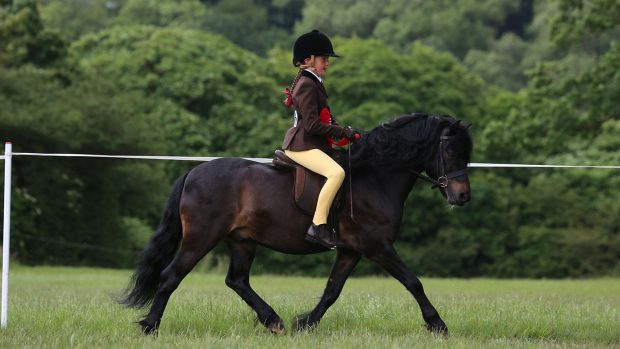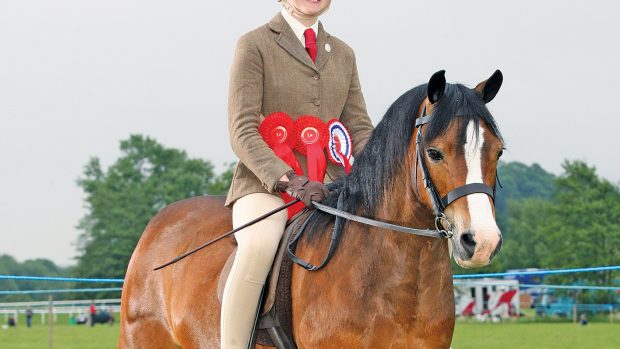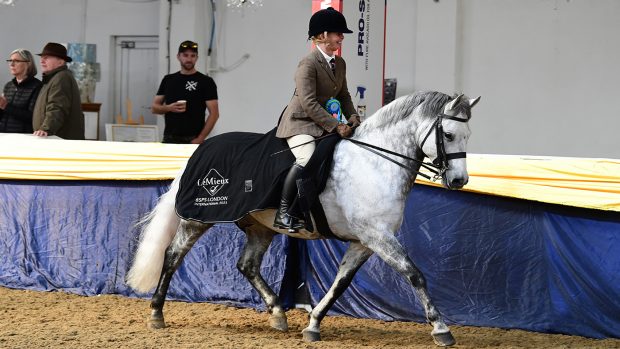If you own a native pony with a pop perhaps you should consider showing him or her over sticks in mountain and moorland (M&M) working hunter pony (WHP) classes. The following expert insight will help you make the most out of your competition season and avoid common mistakes:
Classes and breeds
M&M working hunter pony classes are open to all of the native breeds. The classes are judged on a jumping phase over rustic fences as well as an individual show and conformation assessment.
All ponies exhibited in these classes must be registered in the main body of the pure-bred stud book of their respective breeds. Part-breds are not eligible to compete. The breeds are divided into four height divisions (see below) and start from the very smallest of breed – the Shetland pony – up to the largest — the Welsh section D.
Height specifications for pure-bred M&M ponies entered in their respective breed society books are:
- Shetland: not exceeding 107cm
- Exmoor: stallions and geldings preferred to be 119.4cm – 129.5cm. Mares between 116.8cm and 127cm
- Dartmoor: not exceeding 127cm
- Welsh section A: not exceeding 121.9cm
- Welsh section B: not exceeding 137.2cm
- Welsh section C: not exceeding 137.2cm
- Connemara: 128cm to 148cm
- New Forest: not exceeding 148cm
- Dales: preferred to be 142.2cm – 148cm. Ponies above and below this range to be placed at the discretion of the judges
- Fell: not exceeding 142.2cm
- Highland: not exceeding 148cm
- Welsh section D: exceeding 137.2cm but no upper height limit
Class options
In 2013 the number of M&M WHP classes were split into four height divisions, with new fence height and spreads, as opposed to the former three sections. The idea for the changes was to create a more equal playing field, in which the athletic ability of each breed was taken into account rather than its height.
The four class divisions are:
- Not exceeding 122cm. Maximum height of fences 65cm
- Exceeding 122cm but not exceeding 133cm. Maximum height of fences 80cm
- Exceeding 133cm but not exceeding 143cm. Maximum height of fences 90cm
- Exceeding 143cm. Maximum height of fences 1m
The increase to four classes has enabled ponies, which were previously at the lower end of their height sections, to now jump slightly smaller fences that are more suited to their abilities.
The jumping phase
“It’s very important that time is spent on flatwork, even with the working hunter ponies,” advises Gill Wright, National Pony Society (NPS) judge and representative of the native breed societies. “A good jumping style and attitude can be completely wasted if a jumping round is spoilt by bad manners between the fences. I’m looking for a smooth round with supple, balanced turns at a fairly constant speed.”
It is vital that competitors walk the course carefully.
“I like to see good use made of the ring with riders going into the corners so that they give their ponies the best chance of seeing the upcoming fence in good time,” adds Gill, who breeds New Forest ponies at her own Burley Stud.
“It’s also a good idea to check the distance between the combination fences so they can adjust their approach accordingly.”
“The heavier native breeds tend to get in deep to their fences and can find the spreads quite a challenge,” explains Gill. “They don’t normally give the fences as much clearance and reach for the ground close to the back of the fence.
“This jumping style shows their draught background and heritage, breeds that were bred primarily for power and strength rather than speed.”
“These ponies are often far more athletic,” says Gill. “They generally show more scope over the jumps and usually give the fences more room, using their backs and making the classic jumping shape.
“The extra scope means they can stand further off their fences and usually take the spread fences with ease.”
Gill emphasises that it’s important the judges take all of these breed factors into account when marking the round for jumping style.
Correct way of going
“The individual ridden phase of the class is similar to the individual show of a flat class. I look for a smooth, supple show with complete obedience and if the ring size allows, a good gallop,” says Gill. “The gallop should show a lengthening of stride with the pony lowering to the ground and showing reasonable speed. It’s important that the pull up is mannerly and balanced. To finish I like to see the pony stand without fidgeting until it is dismissed.”
Conformation
“The conformation phase is the same as it is for a flat ridden class, although I’m more tolerant of the odd blemish in a working pony,” adds Gill. “I look for the pony that best matches its breed description in type, action and conformation, and is trimmed to the individual breed specification.”
Natives should move freely, straight and be in a fit — not fat — condition.
“This is particularly important for working hunter ponies. From a judge’s point of view it’s quite distressing to see overweight ponies having difficulties with their jumping rounds.
“Competitors should be aware that their ponies need to be quite fit to compete and carrying a lot of extra condition, especially when the ground gets hard in the summer, means concussion when landing after each fence can be extreme.
“I do like to look for a pony that I would like to ride myself,” continues Gill. “One that would be comfortable, mannerly and obedient but which shows an athletic and confident jumping ability. It must exhibit strong type characteristics and be instantly recognisable as a true example of its own breed.”
Tack and turnout
- Bridles (including browbands) should be plain and workmanlike. Gill states that she doesn’t mind martingales being used when she’s judging a working hunter pony class.
- Either use no numnah or one that is discreet and matches the pony and saddle.
- Straight cut or working hunter saddles show more of the shoulder and movement, so are preferable to general-purpose saddles.
“Competitors tend to ride in saddles that are more forward cut than the flat classes,” adds Gill.
- Use brown or black tack. Bear in mind that brown is preferred by traditional judges and is always correct in the show ring.
- Choose your bit wisely — and remember novices should be in snaffles.
“The most important thing is that the pony to go forward happily and kindly, and I don’t mind what bridle is used to achieve this result,” reasons Gill. “However, a bit that is too severe can result in a lack of confidence, causing the pony not to go forward, hollow its back and lose confidence over the fences.”
- The rules allow protective boots to be worn on the pony’s fore limbs for the jumping and ridden phase, although these must be removed for conformation judging.
- “Riders in all classes should wear tweed jackets, breeches or jodhpurs, shirt and tie and current standard riding hats,” states Gill.
- Manes, tails and feathers may be pulled or trimmed for some breeds — but check with the breed society’s specifications
Remember, the breed societies all produce showing rules and it is important that competitors make themselves aware of them and follow them.
Where to compete
All major shows have classes for M&M working hunter ponies, culminating in a championship. Some shows host mixed height classes where all the breeds jump their respective heights but are all judged together.
The biggest accolades an M&M WHP can win are the Royal International (RIHS) championship, or the M&M WHP of the year final held at Horse of the Year Show (HOYS) in October.
In 2019, Welsh section D Penstrumbly Calon Lan (Ellie Callwood) was champion at the RIHS, while at HOYS Connemara Laburnum Richard (Amy Smith) took the top title.
Horse & Hound magazine, out every Thursday, is packed with all the latest news and reports, as well as interviews, specials, nostalgia, vet and training advice. Find how you can enjoy the magazine delivered to your door every week, plus options to upgrade to access our H&H Plus online service which brings you breaking news as it happens as well as other benefits.




